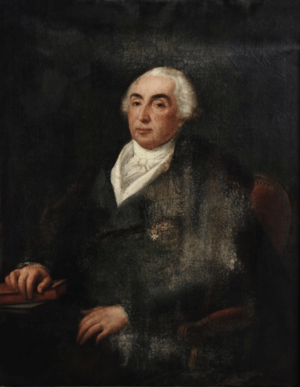Diogo de Carvalho e Sampayo facts for kids
Quick facts for kids
Diogo de Carvalho e Sampayo
|
|
|---|---|

Diogo de Carvalho e Sampayo
|
|
| Born | 28 May 1750 Casa do Poço, Lamego, Portugal
|
| Died | 29 December 1807 (aged 57) Casa do Poço, Lamego, Portugal
|
| Resting place | Lamego Cathedral |
| Alma mater | University of Coimbra |
| Spouse(s) |
Maria Cândida de Albergaria e Vasconcelos
(m. 1806) |
| Scientific career | |
| Fields | Optics, colour theory |
Diogo de Carvalho e Sampayo (born May 28, 1750 – died December 29, 1807) was an important person from Portugal. He was a nobleman, a judge, a diplomat, and a scientist! He was also a knight of the Order of Malta. Even though he was a judge by job, he became famous as a scientist who wrote two important books about colors.
Contents
Early Life and Career
Diogo de Carvalho e Sampayo was born in a manor house called Casa do Poço in Lamego, Portugal. His family was well-known and important. He studied Law at the University of Coimbra.
After finishing his studies, he worked as a judge in Viana do Castelo in 1783. He later left this job after a disagreement with local leaders in a nearby town.
Joining the Knights of Malta
When he was 35 years old, Diogo joined the Order of Malta. This was a very old and respected group of knights. While he was staying in Malta, he became very interested in the science of colors. This interest led him to write his two famous books.
His Work on Color Theory
Diogo de Carvalho e Sampayo quickly wrote two books about colors. The first one, called Tratado das Cores (which means "A Treatise on Colours"), was published in 1787. The second book, Dissertação sobre as Cores Primitivas ("A Dissertation on Primitive Colours"), came out in 1788.
Sampayo created his own system for understanding colors. He believed there were six main colors: white, black, yellow, red, blue, and green. He called these "generic colors." He then showed how each of these main colors could be mixed with the other five. Each mix had three steps in between, making 15 different color scales. His system was special because it was one of the first to show simple color scales with different shades and tints, including a gray scale.
A famous German writer and scientist named Johann Wolfgang von Goethe knew about Sampayo's work. Goethe even mentioned Sampayo's 1791 book, Memória sobre a Formação Natural das Cores ("An Essay on the Natural Formation of Colours"), in his own important book, Theory of Colours, which was published in 1810.
Diplomatic Missions
Starting in 1789, Diogo de Carvalho e Sampayo moved to Madrid, the capital of Spain. There, he worked as a diplomat for Portugal. He started as a chargé d'affaires, which is a temporary head of a diplomatic mission. Then he became a minister plenipotentiary, and finally an ambassador extraordinary. This meant he was Portugal's top representative in Spain. He returned to Portugal for good in 1801. While in Madrid, he met another important person, Wilhelm von Humboldt.


